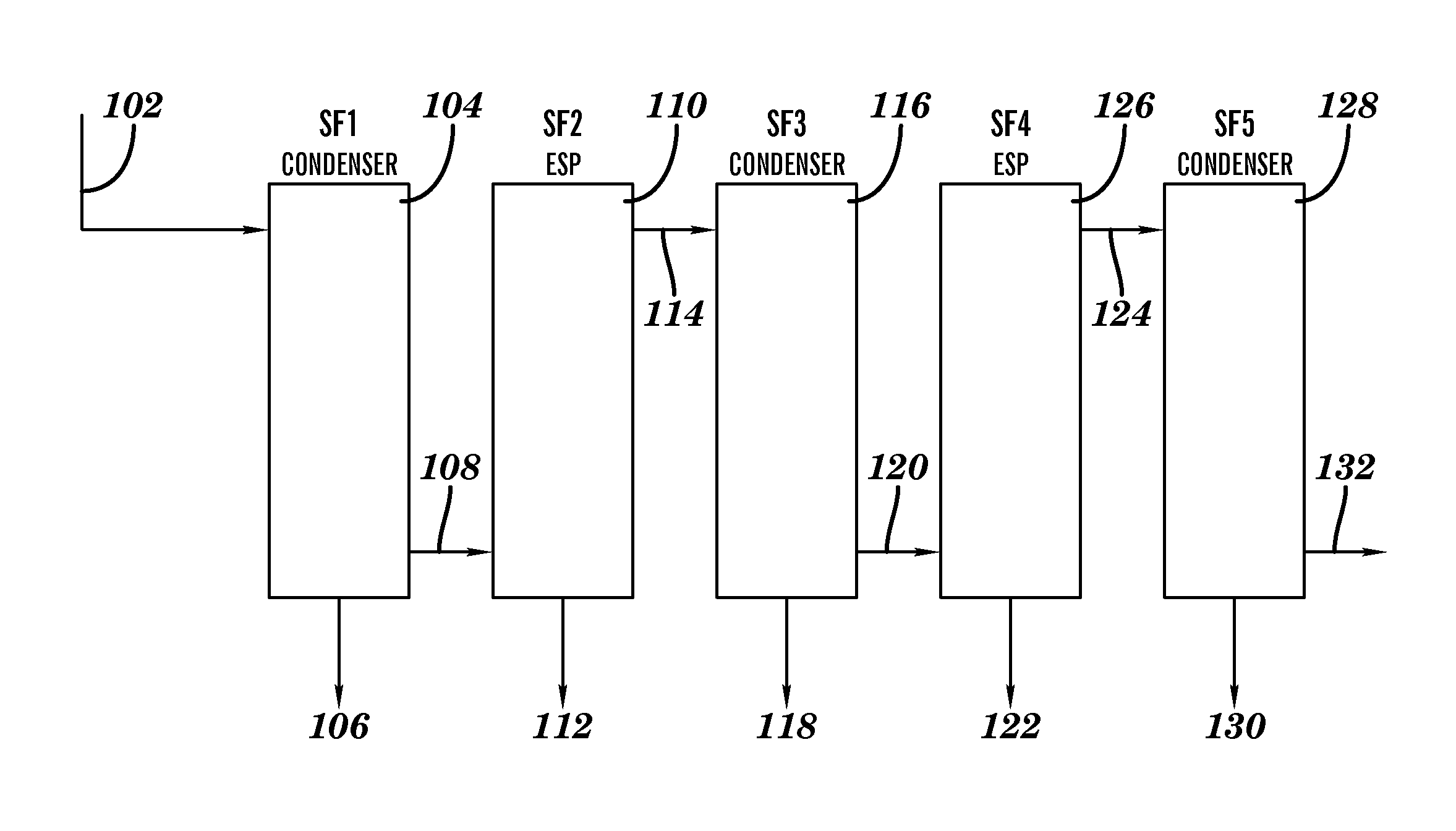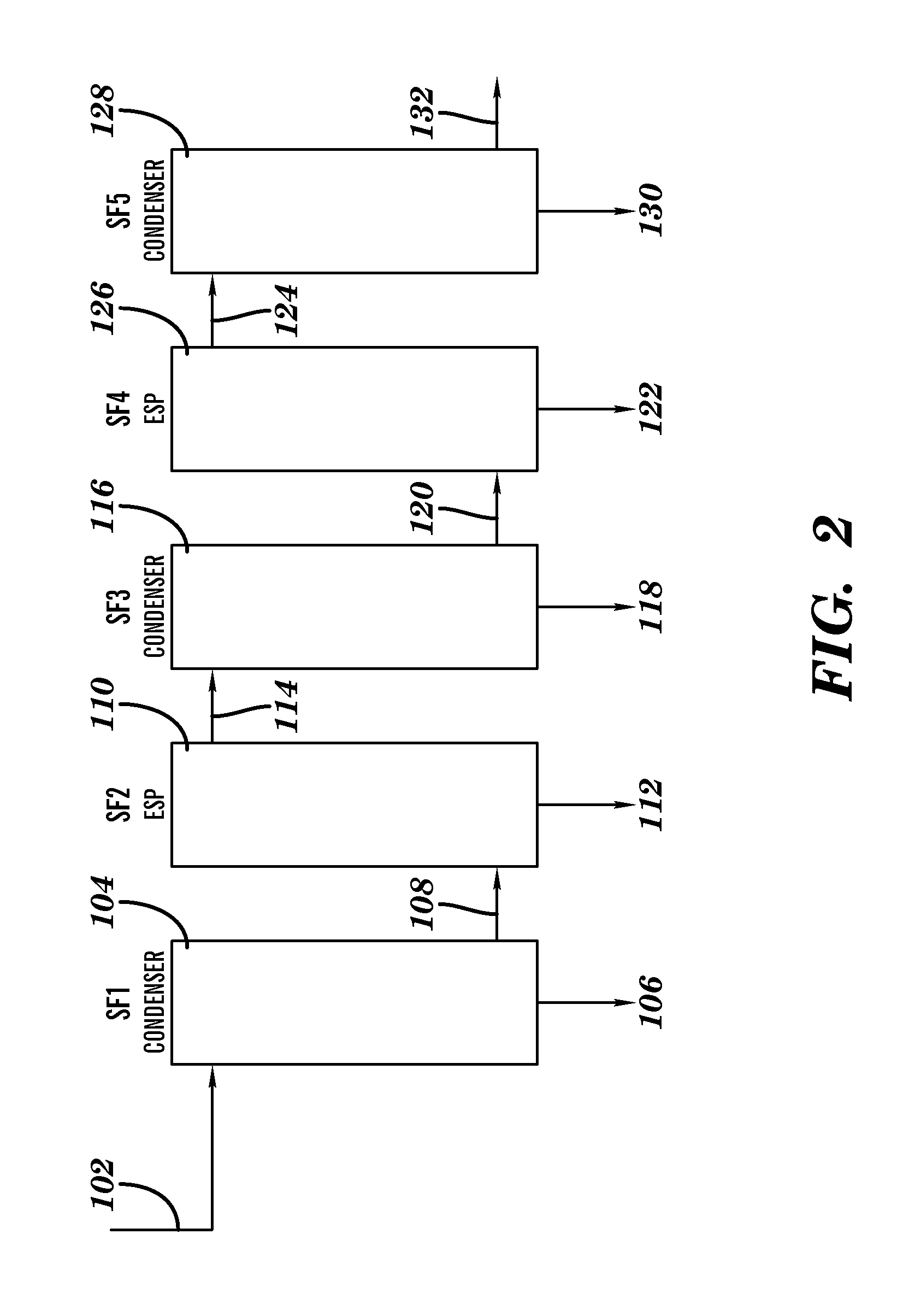Bio-oil fractionation and condensation
a technology of biooil and fractionation, applied in biofuels, organic chemistry, fuels, etc., can solve the problems of high oxygen content, large amount of hydrogen consumed during hydrotreatment, corrosion of instruments, etc., and achieve the effects of less usable and valuable oil, poor stability, and poor combustion performan
- Summary
- Abstract
- Description
- Claims
- Application Information
AI Technical Summary
Benefits of technology
Problems solved by technology
Method used
Image
Examples
example 1
Typical Test Operation
[0093]The bio-oil collection system consists of three bio-oil vapor condensers and one or more electrostatic precipitators (which act as aerosol filters), as described in FIG. 2. Each of these components has been designed to collect a specific fraction of the bio-oil. This document provides a detailed description of the design and operation of the bio-oil collection system, referring specifically to the performance of an 8 kg / h process development unit constructed by Iowa State University at the BECON Facility in Nevada, Iowa.
[0094]Multiple tests have been completed of the bio-oil collection system. Tests have been completed using red oak, corn stover, and switchgrass. For these tests of the bio-oil collection system, the configuration was as follows: condenser 104 (SF1), ESP 110 (SF2), condenser 116 (SF3), ESP 124 (SF4), condenser 128 (SF5). Below is a detailed description of the operation of the bio-oil collection system during a single test.
[0095]Fast pyroly...
example 2
Fractionation of Red Oak
[0098]FIG. 11 is a chart of the weight percentages of the different bio-oil liquid fractions obtained from the red oak feedstock. Fast pyrolysis vapor produces from red oak in the fluid bed reactor entered the condenser 104 at 345° C. After a passage through a cyclonic filtration system to remove char, these bio-oil vapors entered the first condenser tubes. The tubes walls were maintained at a constant temperature of 95° C. This first stage allowed the condensation of 21% of the weight percentage of first liquid fraction. The remaining vapors proceeded through the second stage which was composed of ESP 110. An average temperature of about 102° C. allowed the condensation of a second liquid fraction of 30%. Vapors exited the second stage and entered the third stage at a temperature of 120° C. The tube walls of condenser 116 were maintained at a constant temperature of 66° C. This resulting condensation bio-oil was evaluated at 6% of the third liquid fraction. ...
example 3
Fractionation of Cornstover
[0100]FIG. 12 is a chart of the weight percentages of the different bio-oil liquid fractions obtained from the cornstover feedstock. Cornstover was fluidized in a reactor held at 512° C. The resulting vapors entered condenser 104 in which the tubes walls were maintained at 87° C. A first fraction was collected at this stage in 8% of the first liquid bio-oil fraction. The remaining vapors continued into the ESP 110 where the inlet and outlet temperatures were held, respectively, at 82 and 125° C. This second stage afforded 18% of the second liquid fraction. The non-condensed vapors entered condenser 116 where the tubes walls were held at a constant temperature of 67° C., 4% of the third liquid fraction was obtained from the original cornstover feedstock. ESP 124 allowed the collection of 12% of the fourth liquid fraction. The temperatures between the inlet and outlet of the second ESP were, respectively, 76 and 78° C. The last stage of the fractionation inv...
PUM
| Property | Measurement | Unit |
|---|---|---|
| temperature | aaaaa | aaaaa |
| temperatures | aaaaa | aaaaa |
| time | aaaaa | aaaaa |
Abstract
Description
Claims
Application Information
 Login to View More
Login to View More - R&D
- Intellectual Property
- Life Sciences
- Materials
- Tech Scout
- Unparalleled Data Quality
- Higher Quality Content
- 60% Fewer Hallucinations
Browse by: Latest US Patents, China's latest patents, Technical Efficacy Thesaurus, Application Domain, Technology Topic, Popular Technical Reports.
© 2025 PatSnap. All rights reserved.Legal|Privacy policy|Modern Slavery Act Transparency Statement|Sitemap|About US| Contact US: help@patsnap.com



